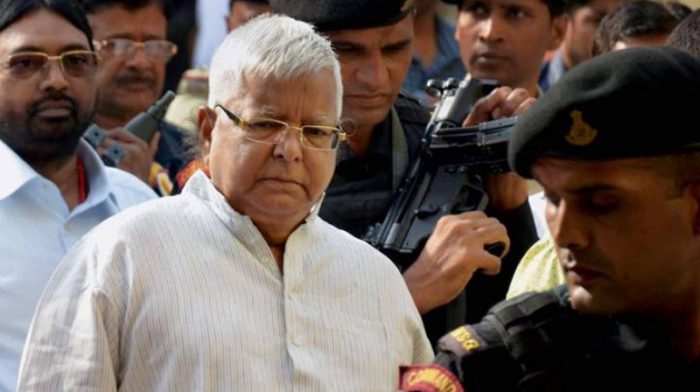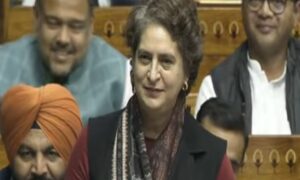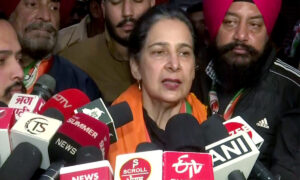
File Picture Courtesy : Deccan Chronicle
One afternoon, in 2005, just before addressing a press conference on passenger amenities and freight movement, the indomitable Railway minister in UPA (I) government, Lalu Prasad announced that he would complete the business quickly as he had to leave to the airport for a flight to Patna, where ‘he had some important job to do’. A few minutes and a quick briefing later, as he stepped out of the Rail Bhawan’s first floor conference room, crammed with reporters covering the beat-the writer was one of them-and senior bureaucrats, Lalu asked the reporters to put the questions to his deputy Naranbhai J. Rathwa. He also advised Rathwa to reply to the queries with the standard, “Hum Dekhenge’, Iske bare main sochenge.” The entire room burst into a noisy laughter.
In India, no politician has ever used humor to the best effect for the longest period of time and made the audience laugh more than Lalu. And none of his contemporaries, across party lines, had a witty, instant reply to all questions. The king of wit, humor, comical phrases laced with a dehati twang and charisma of a born leader, Lalu was arguably the greatest mass communicator of his age and undoubtedly one of the best in independent India. And of course the most sought after leader in Bihar politics, someone whom the rest of the country could hardly ignore.
However, now, after the conviction in the second of the six fodder- scam cases, this month, the former Bihar chief minister and Rashtriya Janata Dal (RJD) president, will require much more than all his gifted qualities to save him from an imminent fall. With the web of corruption allegations around him and his family, away from power in the state and not to forget that he is just about to enter the septuagenarian club, chances of revival of his political fate are bleak. For, since, 1990, when he rose to prominence, much has changed in the political landscape of the country.
While, Lalu’s sworn enemy BJP is the driving political force in the country, winning almost every state polls after its grand victory in the 2014 general elections, his trusted ally, the Gandhi family led Congress has been on a losing streak and struggling badly. Moreover, the party leadership has changed hands from Sonia Gandhi to her son Rahul. Lalu and Sonia shared a very good equation, both understood and respected and stood by the other. It may not be the same for Lalu him with Rahul. Moreover, with elections in some major states round the corner before the 2019 general elections, Rahul’s primary focus will be on better performance by his party, which will silence his critics and help him assert his authority in the Congress itself. At such a juncture, for how long, he would continue his party’s alliance with the RJD and risk carrying the corruption tag, is questionable. Lalu knows that very well.
Going down memory lane it is pertinent to note that 1990 was a watershed year in the post Independent Indian politics, it marked the beginning of a radically new phase: the rise of Lalu Prasad, the regional satrap who would command political attention for over the next two decades. Amidst all power, popularity, success and following, Lalu, referred to as a messiah of the backward castes, a great social engineer, an apostle of secularism-remember the arrest of L K Advani-seemed to have forgotten the very principles that brought him to the center stage. He promised power to the Yadavs and backward classes as well as security to Muslims. But the Lalu story is also symbolic of the degeneration of the politics of social justice. The empowerment did not extend to improvement in livelihoods. Law and order crumbled and corruption allegations mushroomed. Contrary to the Lohia and JP principles, Lalu allegedly championed corruption and nepotism, for which opponents termed his rule as jungleraj. His arrogance, didn’t allow him to read the changing narrative of the country’s politics. It was indeed a huge blunder.
By 2005, after 15 years of Lalu-Rabri rule, Bihar was ready for change. And Nitish Kumar, in alliance with the BJP, created a “coalition of extremes” – the BJP brought in the dominant upper-castes; Nitish focused on the more excluded within marginalised groups. Combined with “development” – improvement in infrastructure and law and order – Nitish and the BJP won a second term in 2010.
However, with Nitish joining hands again with his former friend-turned- adversary Lalu, the RJD-JDU combination staged a sterling performance and silenced a roaring Narendra Modi led NDA in Bihar in 2015. Though Nitish remained the CM , Lalu got cabinet berths for his two sons, including that of deputy chief minister- and remained the kingmaker. But soon cracks appeared on the alliance. In July 2017, after the Enforcement Directorate and CBI lodged several criminal cases against the Lalu, Rabri and son Tejashwi, in another disproportionate assets and railway tender bribery scam, Nitish thought it’s time to bid goodbye to the alliance and return to the NDA fold leaving Lalu bewildered, stunned, worried and desperately insecure.
However, the Bihar strongman has the uncanny ability to spring a surprise and come back to the corridors of power. But, repeating the same magic again may not be easy. Lalu’s love for cows is well known, but its fodder that proved to be his nemesis. The irony couldn’t have been starker.


















